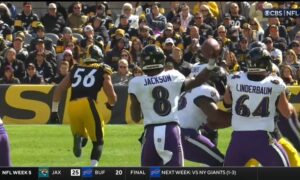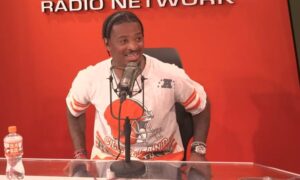By Matthew Marczi
Much has been made of Cameron Heyward over the last couple of days due to the fact that several different media outlets have begun to cover individual players as training camp quickly approaches. Heyward, of course, is a prime area of focus for the Pittsburgh Steelers because he is the team’s only first round selection that is not a rookie that is not currently a starter (barring Plaxico Burress, of course).
A few people have written recently, and in the past months, that there will be a training camp battle between Heyward and the incumbent, Ziggy Hood, another former first round pick, for the starting job at left defensive end.
I recently wrote about Pro Football Focus’ breakdown of the Steelers’ starting lineup, and noted that Hood was one of only three projected starters that the site considered to be below average. In fact, the site considered his play at the position to be poor based on their standards and metrics.
I also wrote about the fact that the website seems to have a much higher opinion of Cameron Heyward than of Ziggy Hood. I understand that many people take issue with Pro Football Focus’ metrics at times, particularly when it comes to something like the responsibilities of a defensive end in the Steelers’ system.
With that in mind, I thought that it would be worth taking a look at their statistics and grades for both players to see how they reached these conclusions. One thing when first looking at the statistics really jumps out at you right away.
Of the 34 3-4 defensive ends that logged at least 25% of the team’s defensive snaps in 2012, PFF ranks Hood 31st overall, but Heyward is ranked 12th (for comparison, Brett Keisel is ranked 21st). These rankings are, of course, based on their overall season grades in rushing the passer, stopping the run, dropping back into coverage, and accumulating penalties.
Hood’s overall grade came out to a -10.0, while Keisel’s was -0.9; however, Heyward produced an impressive 6.8 given his meager 267 snaps. That is in fact the third lowest qualifying total on the list, and everybody ranked above him played between 535 to 982 snaps.
So why, according to this site, did Heyward’s play in 2012 merit 16.8 more points than Hood’s? Their figures should tell the story.
Both Heyward and Hood scored negatively overall in pass rushing, but positively in run stopping. Hood’s pass rushing was an abysmal -15.5 for the season, rating negatively in all but three games. Five times during the season he finished a game with a -1.9 pass rushing grade or worse. As for Heyward, he scored negatively in 12 games; however, most of them were very minor. He also scored numbers of 1.1 and 1.7 in the first game against the Baltimore Ravens and the second game against the Cleveland Browns.
This is very interesting because, of course, these were the two games during the year that he received the most playing time, first replacing Hood due to injury and then Keisel. He also scored some of his highest marks overall in these two games. Is this a legitimate sign that he is better as a starter than as a reserve?
Meanwhile, Ziggy Hood’s run stopping grade comes out at 2.0, but this is somewhat misleading. Leading up to the week 14 game against the San Diego Chargers, Hood’s run stopping grade was actually a -6.5 on the year. Prior to that, he only rated positively twice. However, in the final four games of the season, he accumulated a score of 8.5, including a 3.5 in the Chargers game.
The site also gave him 0.5 for his coverage on the year and 3.0 for penalties, giving him the score of -10.0. As for his raw statistics, by PFF’s numbers, he made 23 solo tackles, added 10 assists, batted three passes, and registered pressure 14 times, including three sacks and three hits. He also added 18 defensive stops on his 833 snaps.
Heyward, on the other hand, really helped his score in the running game, scoring a total of 8.5 in that category for the year. He, too, came on strong at the end of the season there, registering scores of 1.5 and 4.0 in the last two games. However, he had only four negative games last year against the run, and none worse than -1.0.
In terms of his raw stats from the site, he made 16 tackles, adding five assists, with no batted passes. He pressured the quarterback just eight times, including two sacks and one hit, but added 11 defensive stops on his total of 267 snaps.
To wean a bit more out of this data, let’s take a look at percentages. In 302 rushing snaps, Hood registered 15 stops, for a stop percentage of 5. In 107 snaps, Heyward registered 10 stops for a percentage of 9.3. That ranks him as sixth at his position out of those who played at least 25% of the team’s run defense snaps, behind only J.J. Watt, Justin Smith, Muhammad Wilkerson, Jared Crick, and Calais Campbell.
Now let’s consider pass rushing productivity. Pass rushing productivity is simply the percentage of pass rushing snaps on which a player generates pressure, with sacks weighted more heavily than hits and pressures. 3-4 defensive end is not a glamor position in terms of rushing the passer, despite Watt doing his damnedest to change that. Yet he led the position at just 10.8 by generating pressure on over 13% of his pass rushes.
So how do Hood and Heyward fare on this metric? Not particularly well. While Heyward played less than 25% of the team’s pass rushing snaps, he does rank 31st out of all 71 defensive ends in Pass Rushing Productivity with a rating a 4.5. He managed eight pressures (including two sacks) on 144 pass rushing snaps.
Meanwhile, Hood finished 51st in that pool (29th among the 31 players at his position to play 25% of the team’s pass rushing snaps). His PRP was a meager 2.4 after netting 14 pressures (including three sacks) on 468 pass rushing attempts.
That is just a quick look into the numbers to see if Pro Football Focus’ statistics really back up their adamant support of Heyward over Hood. Does this mean that there will actually be a camp battle for the position, let alone that Heyward would win it? No, of course not. But it does give some insight and background into the rhetoric; take the source for what you will.







